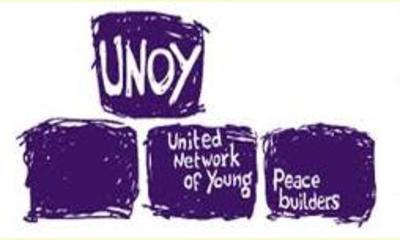|
|
Opportunities for Youth Peacebuilding Initiatives
un article par Fanny Tittel-Mosser
On the 23rd of October 2012, Celina del Felice, a
PhD student at the Centre for International
Development Issues in the Netherlands, came to the
International Secretariat of UNOY Peacebuilders to
give a four hour training on Research, Evaluation
and Advocacy in Youth Peace Building Initiatives.
This is a short overview of the important
opportunities for youth that have been pointed out
by Celina and the UNOY staff during the training.

click on photo to enlarge
There is a strong tendency among politicians and
researchers to see youth as a problem to be
solved. However, by doing this, the potential of
youth as peace-builders is being overlooked.
Although these youths are equally affected by
various forms of violence, there are youth who
decide to act constructively towards building a
culture of peace.
Ignoring the role of youth in peacebuilding is
ignoring their unique power and potential to affect
social change. Celina makes five propositions on
their specific qualities:
1. Young people are more open to change
2. Young people are future-oriented
3. Young people are idealistic and innovative
4. Young people are courageous
5. Young people are knowledgeable about their
peers' realities
When taking these qualities into account, youth
could play an important role in several aspects of
conflict transformation. In conflict prevention,
they could have a monitoring or warning role for
hate speech on radio or in other media. In peace
making, parallel dialogues between youth with
different ideologies can be facilitated by youth
organisations. As peace builders, youth
organisations can function as social researchers
and witnesses. They could keep records of changes
of attitudes in their country and link this to the
conflict prevention. In addition, youth has the
unique capacity to imagine vision and look for
creative solutions.
Regarding youth peace building organisations, it
was agreed that it would be most useful for these
types of organisations to look at attitude changes
in the long-run to measure their impact. This can
be done by, for example, tracing participants
after five or ten years, a discourse analysis or
by doing a social network analysis. The latter
entails the creation of a net-map which
demonstrates the improvements of the participants
in social relations by using for example their
contacts on social media platforms such as
Facebook. Furthermore, opportunities for youth
advocacy work can be found in organizing on local
and regional level.
|








|
DISCUSSION
Question(s) liée(s) à cet article:
Is there a renewed movement of solidarity by the new generation?,
* * * * *
Commentaire le plus récent:
from Javier Collado Ruano, Director of Edition at Global Education Magazine, on the occasion of the International Day of Solidarity.
Solidarity is a trans-dimensional phenomenon that goes beyond the ontological essence of human nature. In fact, when we analyze the connections between the microcosm and the macrocosm, we perceive that human beings are not involved in chaos and arbitrariness, but belongs to the large network of interdependencies, complementarities and reciprocities that constitute life. The emergence of life on Earth, around 3,8 billion years ago, was a complex process of exceptional natural phenomena, inherent in all living systems. A process which is expressed through unlimited creativity: mutation, gene exchange, and symbiosis. From a cosmo-biological perspective, we can understand a new conceptual dimension of life, where all living beings share same basis of genetic code: the twenty amino-acids and four phosphatic bases. In fact, the diversity of living beings is caused by the combination of this cosmo-bio-genetic basis.
This trans-dimensional perspective has a deep ecological and spiritual sense for our worldview because the human evolutionary adventure is the latest stage of life on Earth. The modern human being is a vertebrate animal, mammal, belonging to the primates, which emerged 200,000 years ago. In recent centuries he has imposed its anthropocentric, industrial and capitalist vision to the detriment of Pachamama (and Indigenous goddess known as earth mother). We consume around 120% of the natural resources that Earth Mother regenerats annually. Our consumer behavior is immersed in a fatalistic dynamic with a destiny to climate change (deforestation, loss of biodiversity, ozone, etc.), and our own self-destruction as a species.
There is an urgent need to get beyond the cognitive fallacy that the mental structures of social Darwinism and capitalist postulates of the 19th century have historically constituted, because they only understand natural and social systems as warmongers and competitive processes whereby species diverge from each other. . ... continuation.

|
|









